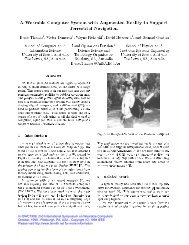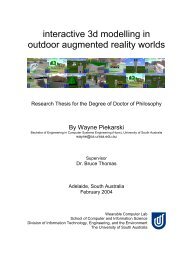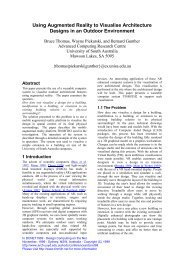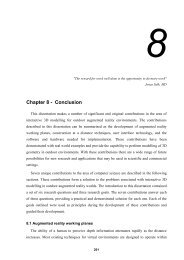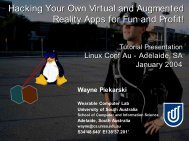Measuring ARToolKit Accuracy in Long Distance Tracking ...
Measuring ARToolKit Accuracy in Long Distance Tracking ...
Measuring ARToolKit Accuracy in Long Distance Tracking ...
You also want an ePaper? Increase the reach of your titles
YUMPU automatically turns print PDFs into web optimized ePapers that Google loves.
<strong>Measur<strong>in</strong>g</strong> <strong>ARToolKit</strong> <strong>Accuracy</strong> <strong>in</strong> <strong>Long</strong> <strong>Distance</strong> Track<strong>in</strong>g ExperimentsPierre Malbez<strong>in</strong>, Wayne Piekarski and Bruce H. ThomasWearable Computer LaboratorySchool of Computer and Information ScienceUniversity of South AustraliaMawson Lakes, SA, 5095, Australiapierre@t<strong>in</strong>mith.net, {wayne, thomas}@cs.unisa.edu.auAbstractThis paper presents the results from an experiment whichwas performed to test the <strong>ARToolKit</strong> and the accuracy of itstrack<strong>in</strong>g over large distances of 1 to 3 metres. We used AR-ToolKit to extract the position of a camera po<strong>in</strong>ted at a fiducialmarker, and compared these values to physical measurementsto quantify the accuracy of the track<strong>in</strong>g. The results<strong>in</strong>dicate that the error <strong>in</strong> position <strong>in</strong>creases with thedistance from the target, and that the error also varies <strong>in</strong> Xand Y <strong>in</strong> phase opposition when orbit<strong>in</strong>g around the pattern.We suggest further experiments to perform and the creationof filters which could reduce at least 75% of the errors detected<strong>in</strong> this <strong>in</strong>itial experiment.1. IntroductionThis paper presents the results of some experiments wehave been perform<strong>in</strong>g which are designed to measure theaccuracy of the <strong>ARToolKit</strong> [1] track<strong>in</strong>g software. ARTool-Kit is commonly used <strong>in</strong> augmented reality (AR) applicationsto detect fiducial markers and overlay a 3D object atthis position, usually with<strong>in</strong> arm’s reach. In these applications,the distance between the user and the target is oftenquite small (less than one metre), and so many errors are notnoticeable except at larger distances.In some cases, it may be desired to use <strong>ARToolKit</strong> <strong>in</strong> largerscale environments, but there has not been much previouswork <strong>in</strong> this area, and so we decided to test its accuracy.At large, room sized distances, accuracy seems to depend onthe angle that the target is at, with either the corner or theside fac<strong>in</strong>g the camera. The aim of the experiment described<strong>in</strong> this paper is to test <strong>ARToolKit</strong>’s position<strong>in</strong>g accuracy fordistances between 1 and 3 metres, and at different angles.We first expla<strong>in</strong> how the experiment was performed, andthen analyse the results.2. Experimental setupFor this experiment, we fixed a fiducial marker on thefloor of a large empty room, and drew four circles centredon the target at a distance of 1, 1.5, 2, and 2.5 metres. Atdistances of 3m and higher, the camera had difficulties detect<strong>in</strong>gthe target and so 2.5m was set as the upper limit (seefigure 3).Figure 1 – Asymmetrical 20 cm x 20 cm pattern used for the experimentFor the fiducial marker pattern, we wanted to orbitaround it with the camera and calculate position and orientation,so an asymmetrical pattern (see figure 1) was created.The marker was 20 cm x 20 cm and glued onto a flat rigidsurface to ensure that it was held as straight as possible.The next step was to fix the marker down <strong>in</strong>to the middleof a solid rectangular surface. This surface was then placeddown on the floor of the room, and it was estimated that theerror <strong>in</strong> this position was a maximum of 2 mm, contribut<strong>in</strong>gan error of 0.3 degrees. Once the board was placed downonto the floor, we create straight l<strong>in</strong>es <strong>in</strong> the direction of theX and Y axes, us<strong>in</strong>g the perpendicular bisector method onthe corners of the board. These axes allow us to measure theposition of the camera relative to the marker, and the errorcontributed by the placement of these axes was estimated at0.2 degrees.To draw the circles around the fiducial marker at the centre,we used a 3 metre long piece of str<strong>in</strong>g pulled tight,which could be rotated about the centre. Four marks on thestr<strong>in</strong>g at 1m, 1.5m, 2m, and 2.5m <strong>in</strong>dicated the po<strong>in</strong>ts for thecamera to be placed at. The angles that the camera wasplaced at were at about every 15 degrees. The positions ofthe camera were calculated by project<strong>in</strong>g onto the axis, andthis process contributes an error of about 5mm.The camera used for the experiment is a 1394 FirewireFigure 2 – View of the experimental setup
Pyro WebCam, which allows most of the sett<strong>in</strong>gs to be altered<strong>in</strong> software (camera parameters show <strong>in</strong> Figure 7). Thecamera was fixed onto a tripod to make it more stable andable to be measured accurately, and was placed at a heightof 1.34m. A plumb l<strong>in</strong>e stretched beneath the tripod to theground po<strong>in</strong>ts to where the camera stands on the floor so thatwe can get as accurate placement as possible. The camera isaimed down toward the pattern and the image is centred onthe pattern to avoid image distortion problems.The test<strong>in</strong>g program we developed for the experimentuses the <strong>ARToolKit</strong> functions to calculate the position of thecamera relative to the target. For each position of the camera,the program calculates the matrix 1000 times and averagesthe values to remove any noise <strong>in</strong> the measurements.3. Experiment results and analysisFor the accuracy of the measurements, we noticed thatthe Y position is always more accurate than the X position,as shown <strong>in</strong> figure 4. We believe it might be that the X axiscreated at the start of the experiment may have had a largererror than the Y axis.For each of the po<strong>in</strong>ts processed, it appears that the radialdistance estimated by <strong>ARToolKit</strong> is always a larger valuethan the real measurement, and figure 5 shows the estimatedand measured circles with this demonstrated.In figure 4, we can clearly see that the error <strong>in</strong>creaseswith distance, from 9% to 18% for Y and from 6% to 12%for X. It might be possible to correct for this error by add<strong>in</strong>ga filter which would estimate the distance to the target basedon the values from ARToolkit. As a first step for this calibration,a l<strong>in</strong>ear function could be tried to see if it helps improvethe accuracy. To extend this filter to other cameras orsett<strong>in</strong>gs, it would then be enough to measure the error at 1mand 2.5m and then <strong>in</strong>terpolate the values <strong>in</strong> between.F<strong>in</strong>ally, another result from the experiment is that the accuracyof the X and Y values fluctuates with the angle thatthe camera is at to the target, as shown <strong>in</strong> figure 6. The resultsshow that the X values are more accurate around 90 oand 270 o , while the Y values are more accurate around 0 oand 180 o , which is the opposite of the X values. This maycome from the pattern design, but for now we are not sure ofthe cause of this phenomenon.4. ConclusionError<strong>Distance</strong> (m) 1 1.5 2 2.5Error (mm) ± 14 ± 18 ± 22 ± 27Figure 3 - Maximum error values for the four distances20.00%15.00%10.00%5.00%0.00%In this paper, we described an experiment that was performedto measure the position<strong>in</strong>g accuracy of <strong>ARToolKit</strong> atdistances between 1m and 2.5m. It appears that the error <strong>in</strong>the X and Y values <strong>in</strong>creases with the distance from the target.Also, the accuracy of X and Y appears to change withthe angle from the target, although at opposite phases.Us<strong>in</strong>g these results, it should be possible to use a correctionfilter that would detect the angle and distance, and thencorrect the X and Y values up to 75% of what was measured.Also, to better understand the problems be<strong>in</strong>g <strong>in</strong>vestigated<strong>in</strong> this paper, we th<strong>in</strong>k it would be <strong>in</strong>terest<strong>in</strong>g to repeatthe experiment but with the follow<strong>in</strong>g changes: us<strong>in</strong>g differentcamera models and lenses; do<strong>in</strong>g the same tests at otherdistances; test<strong>in</strong>g the proposed l<strong>in</strong>ear correction method; andus<strong>in</strong>g a different marker pattern. While the results <strong>in</strong> thispaper are prelim<strong>in</strong>ary, it gives a start<strong>in</strong>g po<strong>in</strong>t for future research<strong>in</strong>to quantify<strong>in</strong>g the accuracy of the <strong>ARToolKit</strong>.5. References935 1445 1949 2461RadiusError XError YFigure 4 – X and Y mean error values for the four radius values0-3000 -2500 -2000 -1500 -1000 -500 0 500 1000 1500 2000 2500 3000-500Real Position30002500200015001000500-1000-1500-2000-2500-3000<strong>ARToolKit</strong> PositionFigure 5 – <strong>ARToolKit</strong> radius estimates are always larger than actual physicalmeasurements (units are millimetres)5%0%-5%-10%-15%-20%180 149 119 90 59.5 29.5 0 329 300 270 239 210Error XError YFigure 6 – X and Y error values change with the angle (units are degrees)Size = (640, 480) | 750.51 0.00 320.00 0.00 |Centre = (320, 240) | 0.00 722.98 240.00 0.00 |Focal = 60.900000 | 0.00 0.00 1.00 0.00 |Size = 1.036854 | 0.00 0.00 0.00 1.00 |Figure 7 – ARToolkit parameters for the 1394 Pyro camera, straightened tocorrect for <strong>in</strong>accuracies <strong>in</strong> the calibration process[1] Kato, H. and Bill<strong>in</strong>ghurst, M. Marker Track<strong>in</strong>g and HMD Calibrationfor a Video-based Augmented Reality Conferenc<strong>in</strong>gSystem. In 2nd Int'l Workshop on Augmented Reality, pp 85-94, San Francisco, Ca, Oct 1999.


